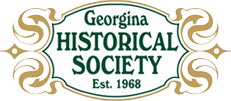Click to Download the PDF
Download the Word Doc
President’s Message
Welcome to tke September edition of the Georgina Historical Society Newsletter. There was a great turnout for the June General Meeting held at St George’s Anglican Church. Andrew Sibbald welcomed us and gave us a tour of the church, and the cemetery. He gave a very interesting talk on the history of the church and cemetery…Thank you Andrew for sharing with us the history of the church, the cemetery, and your family.
A big thank you to all the members who helped out at the booth at Sutton fair; we had lots of visitors expressing interest in the Historical Society and the town’s history. Harvest Day, on September 14, at the Pioneer Village is fast approaching. It is not too late to volunteer or contribute baking to our bake sale.
September 17 the General Meeting of the Historical Society will be held in the Noble House at the Pioneer Village. Sarah Harrison will be speaking on the Cedarbrea School.
Hope to see you all there.
We have a vacancy on the Georgina Historical Society Board. If you are interested, or would like more information, please contact me or any board member.
~ Tom Glover
The One Room Schoolhouse
We are fortunate that in 1996, for the 100th anniversary of SS # 5 North Gwillimbury, better known as Mount Pleasant School, that Dorothy Sheppard Bosworth wrote her memories of teaching at Mount Pleasant in the years 1929 -1931. It seems appropriate at the beginning of a new school year to reprint the following article to remind us of how much things have changed in our schools today. (Our thanks to Tom Glover for contributing this article for republishing.)
“Remembering Teaching in Mount Pleasant School (1929-1931) ” – By Dorothy Sheppard Bosworth
“In those years times were tough, jobs were scarce, no married woman was allowed to teach. Those jobs were reserved for the singles who had no one to keep them. There was no hydro in the community so we had no lights, no running water,, no bathrooms, simply twin outhouses at the back of the school, equipped with old Eaton’s catalogues. In spite of these lacks we never had any serious outbreaks of illness. Without lights, sometimes in November on dull, gloomy days it was impossible for the children to see their work; so I stood by a window and read to them. Later they were allowed to draw pictures illustrating the stories. No time was wasted as we were ever conscious of the June examinations which must be passed.
In those days written examinations were sent out from the Department of Education, for all the grades in all the subjects. These had to be written and marked and report cards prepared in the last week in June. No P.A. Days for the teacher to do the marking, etc. we scarcely had time to eat or sleep. Jobs were scarce so it was “Do it or else”! Text books were few but were standard throughout the province. If students moved they met familiar books and teaching.
There was no prepared seat work available, so each teacher had to make up their own for each grade in every subject every day, and usually write it on the blackboard. The grade 8 girls sometimes helped with this.
Grade 8 wrote their high school entrance in Sutton for three days under the supervision of a strange teacher. There was no automatic passing; if you failed it was back to the old school until next year; or if you were 14 years old you could quit school and work on the farm. Most came back because they wanted their high school entrance certificate. Teaching all grades in all subjects in one room takes a lot of organization and cooperation; but the children seemed to understand and were very helpful. Some always finished their assignments before the others and would quietly go and perhaps give grade 3 their spelling, etc.
They were all good country children but children never the less; and would try out a teacher to see if they could “get her goat” so to speak. One day I lifted the lid on my desk, and there was a dead mouse. I picked it up by the tail and dropped it in the garbage as if it were an ordinary thing to do. I didn’t even ask “who done it”? The children looked disappointed but didn’t try that again. The first day the furnace was lit in the fall it smoked badly. One of the boys suggested we go home; the teacher before me had let them go home when the furnace smoked. I went down to the basement, walked around behind the furnace and pulled a quantity of rags out of the damper.
I threw them into the furnace and the fire went normally. Again I didn’t question anyone and it was “business as usual.”
At Christmas time, making up tests, marking them, and getting out reports for the whole school, which was between 39 and 54 pupils, I had to organize a concert which would consist of plays, recitations, songs, drills, so that every pupil was in something. The parents all came out to see their little Jimmy or Jane perform. It was the highlife of the year and it had to be good. They expected and got at least two hours of entertainment. We took up a collection and got enough money to buy a new baseball and bat and perhaps a glove.
Yes I had a strap which was seldom used, about once a year; that was all that was needed. The children knew it was there and they knew I meant business if I had to use it; so I did not have to wear it out, and we have all remained friends throughout the years. The ceiling in the school was at least 15 feet high, and since there were no storm windows or insulation in really cold weather it was almost impossible to get the place warm until about noon. I knew the caretaker had the fire on early as I could see the smoke from the chimney before I got out of bed in my boarding house a mile down the road. We made good use of the big register in the middle of the room to dry out mittens, socks, etc. after the noon hour play in the snow. We put up poles over chairs and hung the wet things there to dry and be warm for the long walk home.
I often wonder how the children learned as much as they did, but in a room full of activity they learned how to concentrate and be self-reliant. Of all those children I can’t remember any to be on welfare. Most were very successful citizens and a credit to themselves.”
~ Dorothy Bosworth 1996
John Prosser (1794-1852) : An Early Pioneer Farmer
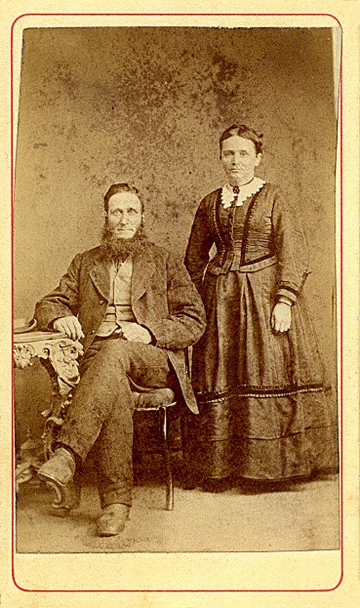
Left – John Prosser and his wife Sarah Willoughby
Picture taken between 1835 and 1841 in Medina (now Keswick)
The picture to the left was forwarded to us by Jim Prosser showing his four times great grandfather John Prosser and his wife Sarah Willoughby. Jim shared this early photograph with us of his pioneer ancestor who rests with his wife in the Mann cemetery on the north Queensway. John Prosser was a farmer who on April 4th 1821 purchased 100 acres of land in North Gwillimbury on concessions #4 and #5, lots 15 and 16 for £12, the equivalent of $50 at that time. In addition to working as a farmer, John was actively engaged in serving his chosen community as a Justice of the Peace and as the minister of the Lake Simcoe Christian Church, the first of that denomination to be established in the Canadas. If that wasn’t enough, in 1852 he was elected the first mayor of Medina with the voting held at Moors Tavern. This was a common practice then as most of the important gatherings were held in local inns or taverns and they were the usual centres of social gatherings.
John and his wife along with fifteen other Prossers are buried in the Mann cemetery, one of the first cemeteries in this area. Unfortunately, this resting place is in very sad shape today. Jim Prosser is very concerned about this, and with due diligence took the time to discover who is responsible for the maintenance and upkeep of the cemetery. He feels strongly that this resting place for our earliest settlers deserves more honour and respect than has been shown in recent years.
The Mann Cemetery
As a closed cemetery, under provincial legislation, the responsibility for maintenance and upkeep of the Mann Cemetery falls to the Town of Georgina. Jim Prosser contacted them and received a confirmation copy of an e-mail from Ryan Cronsberry to Councillor Neeson that the Town does indeed own the land and has the responsibility for maintenance of this property. To that end, Mr. Cronsberry promised to get in touch with Rob Findall and Ken McAlpine of the Town to look into this. At the recent Board meeting of your historical society, Melissa Matt advised that Town staff had recently walked about the cemetery reviewing the situation and has promised to do something about the problem. Unfortunately, in recent experiences with the Town of Georgina, they have been long on promises and assurances but very short on action.
The following images of the Mann Cemetery were taken September 3rd by your editor before the recent Board meeting. They are but a very small sample of 37 images taken in the rear half of the property to illustrate how bad the condition of the cemetery is.
All 37 images show individual plots with stones lost in the underbrush of small trees and shrubs. Only the most visible sections are maintained reasonably well near the road. This is not a small cemetery. It extends well back away from the Queensway north with almost all the back half of it covered in dense shrubs and underbrush, many with trunks of two to three inches in diameter. In one case a family plot with several graves and markers surrounded by a low metal fence was completely engulfed and overgrown. The open area near the road where the grass is cut indicates that only enough has been done to keep up appearances from the road but very little attempt has been made for some years to brush out overgrown areas. This dereliction of duty by the Town of Georgina is disrespectful and does no honour to those that went before us to carve out this wonderful place we call home from the wilderness.
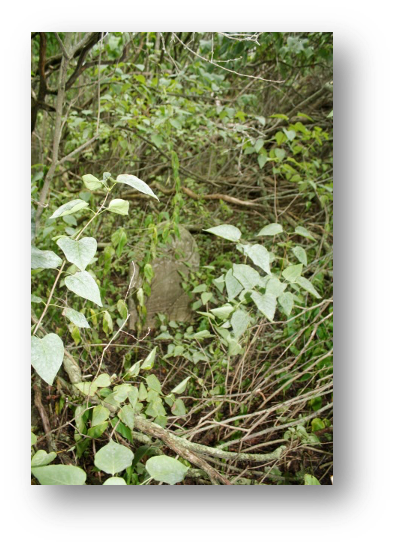
In these images the stones may be readily seen. However, in some of the images you will have to look closely to find the tombstone. Please note these images are but a random sample of the images taken. Our ancestors deserve better from us.
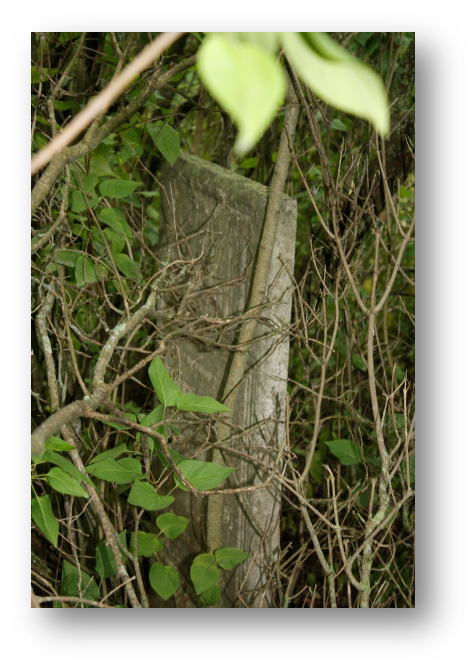
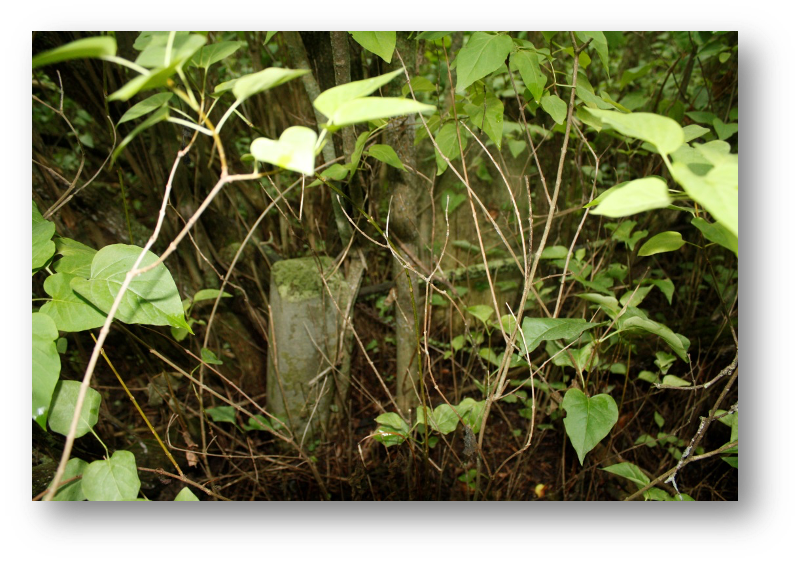
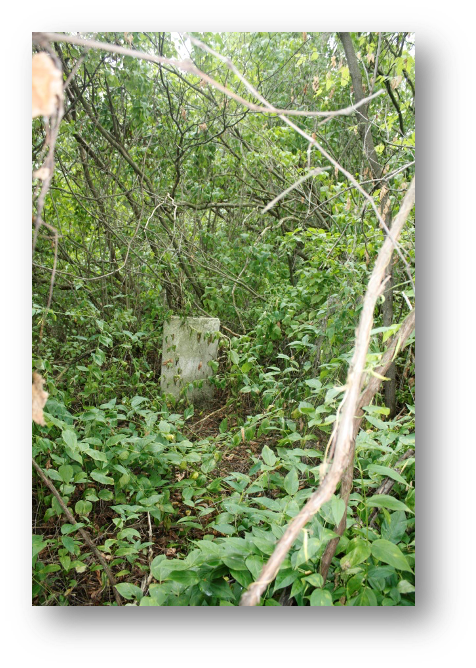
Jake Charles Presentation, May 21st
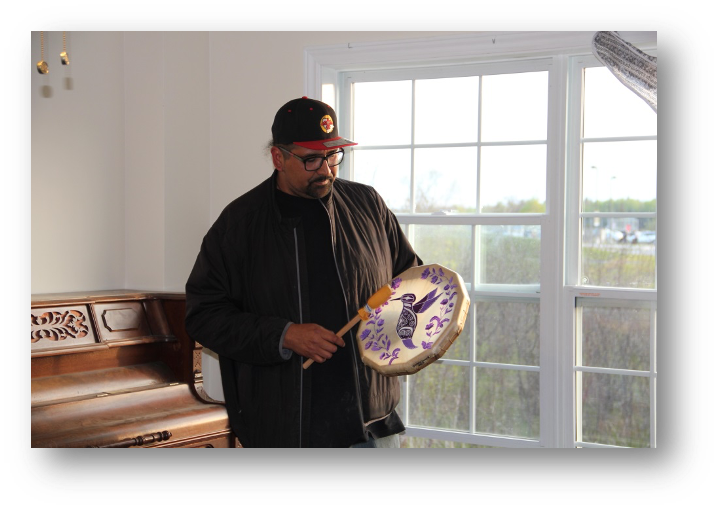

Jake Charles of the Georgina Island Chippewa Band gave a fascinating and wonderful presentation on his native culture and medicine to the general meeting on Tuesday, May21st at the Noble House in the Georgina Pioneer Village.

June at St. Georges Church
Our June general meeting was held at St. Georges Church and cemetery. Andrew Sibbald gave a wonderful presentation on the history of the church. And as he guided us through the cemetery grounds, spoke about the families buried there. He also pointed out the approximate location off-shore from the church grounds where the steamboat ‘Enterprise’ lies on the bottom of the lake.
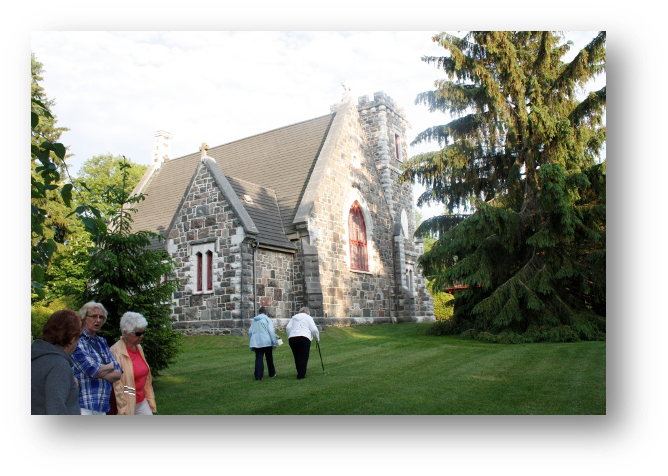
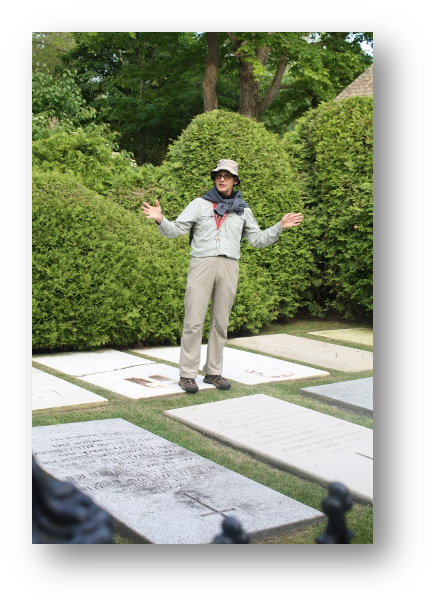

Where in Georgina?
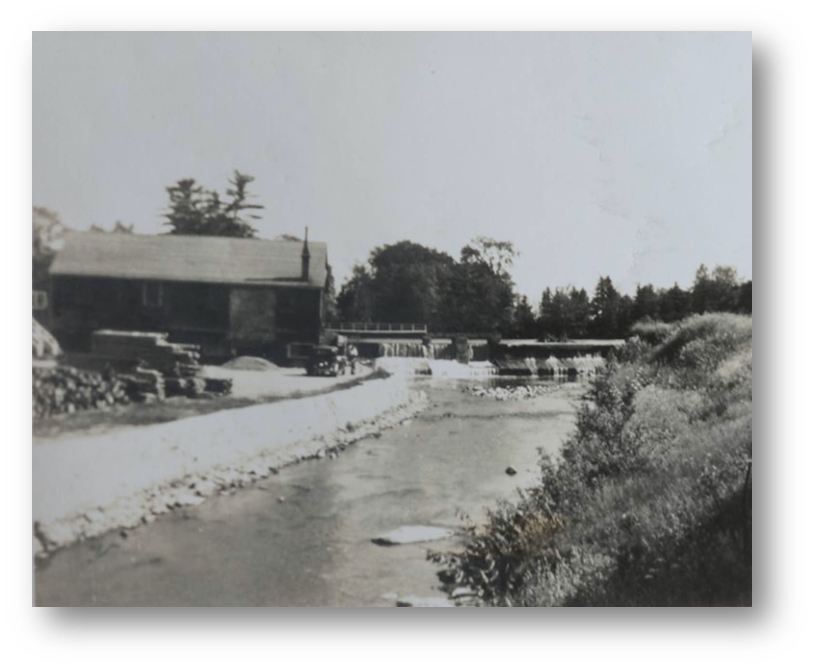
Our last newsletter mystery location was correctly identified by Enid Abram as the Mossington Park pavilion. Kudos to Enid! The picture above is our new mystery location. What is it and where is it located?
News and Events
We had a good turnout of volunteers on Canada Day at the Georgina Pioneer Village. Thank you folks for donating your time to help out; we also had sufficient volunteers for our booth at the Sutton fair. A continuous stream of people stopped by the booth to ask questions and look at our pictures. Many of them bought our books. We think our new location helped with this a lot! Your website committee met again on August 13th to continue their work on rebuilding our website. A proposal for the site map was put together for presentation to the Board and was approved. Members of the Board were asked to submit brief biographies and a head shot photo for the new website. The committee asked them to brainstorm FAQs that might be asked so that answers could be provided on the website. A call was made for a brief history of our society to be written up as well. We throw this one open to the whole membership. These latter items will all be a part of the section ‘About Us.’ The beta version for the site should be completed and running by the end of September. The final version should be debugged and completed by late October. Preparations for Harvest Day Celebrations are in full swing. We could still use more volunteers for decoration and setting up, and bakers for our bake sale. We will be at the pioneer village next week on the 11th, 12th, and 13th to decorate and prepare for the event. For information; please contact Jackie Diasio at 905-476-1329, Paul Brady at 905-853-8005, or Dee Lawrence at 905-722-6535. We have a vacancy on the Board that needs to be filled! If you have the time and energy, join with us to help your executive continue their work in preserving our past. Applications may be made through any member of the Board. See the ‘Contact Us’ list at the end of the newsletter.
Right – Wayne King guides a young visitor in the railway station on Canada Day 2019.
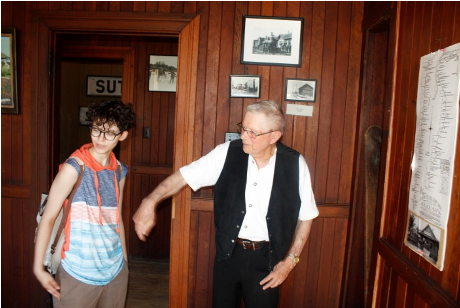
Dates to Remember
Oct. 7th: Next Board meeting; Noble House
Oct. 15th: General meeting – Melissa will do a presentation on Ruth Johnson/Thompson; Noble House
Nov. 13th: Annual General Meeting – to be announced
Nov. 23rd: Christmas Festival of Lights at Georgina Pioneer Village and Old-fashioned Christmas.
